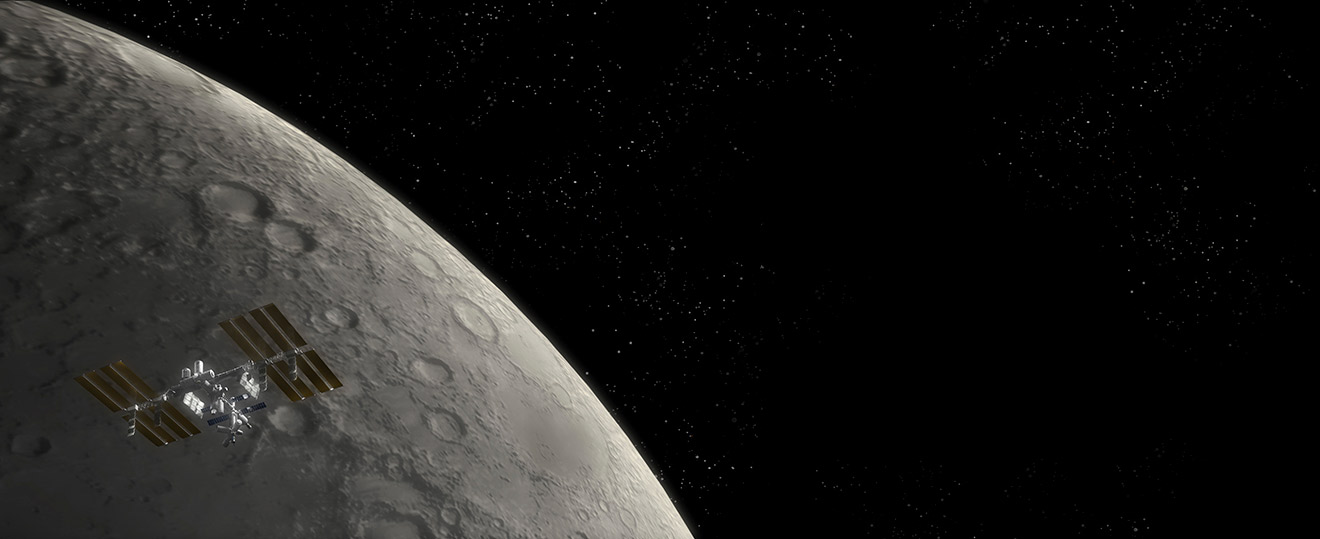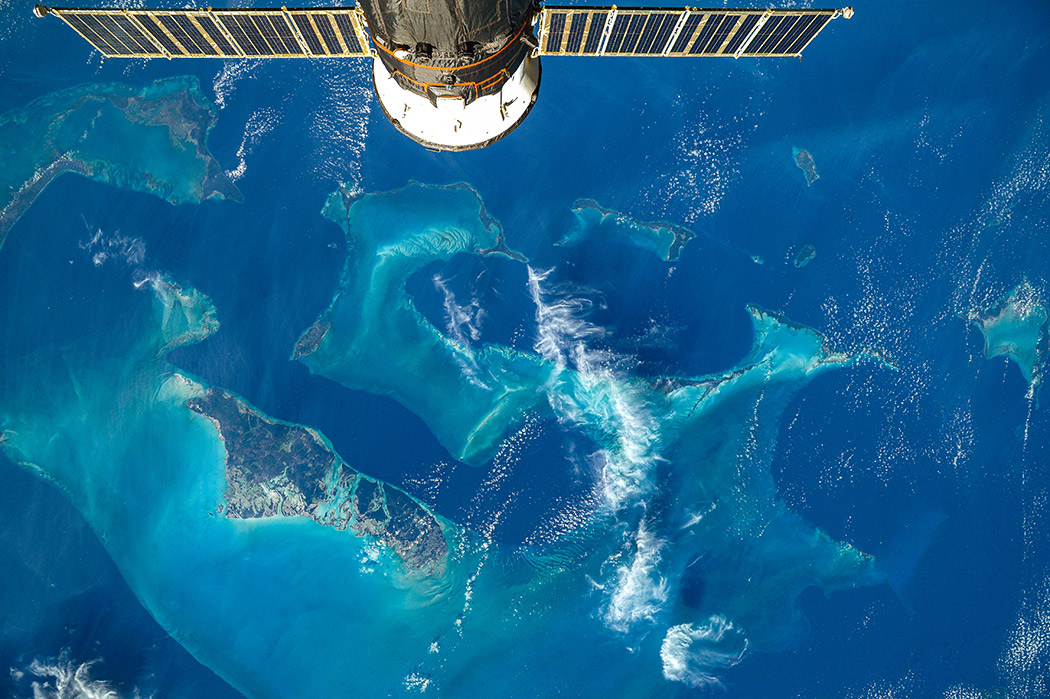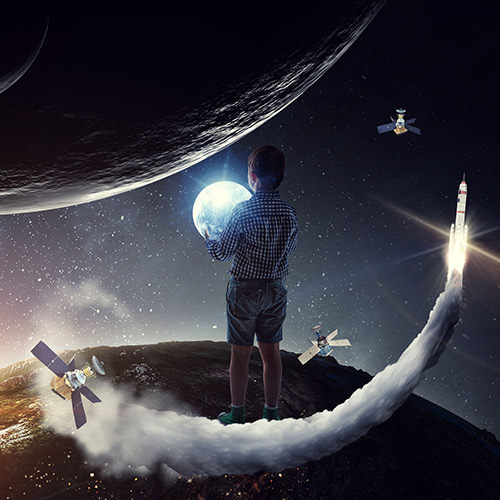
The Space Business
- Spinning the Future of the Earth
In recent years, there has been a lot of attention given to the space business and its status as a new industrial field. This market has been growing rapidly due to the advent of space flights by private companies and the rapid increase in the number of satellite launches, as well as the injection of funds and human resources for space research and development. In Japan, led by the Japan Aerospace Exploration Agency (JAXA), industry, government, and academia are strengthening their joint efforts to inject new energy in the space business, and at the same time, have begun to use the technology and know-how gained from exploring uncharted territory to address environmental, food problems and other issues here on Earth. The great challenge of creating a brighter future for the Earth through the space business has begun.
Space-for-space, a great business opportunity
― Growing momentum in the public and private sectors for lunar exploration and resource development
The physical exploration of outer space began in the 1950s and is now moving ahead at a remarkable pace. According to estimates by Morgan Stanley, Goldman Sachs, and other major U.S. financial firms, the space industry is projected to exceed $1 trillion in revenues by 2040, a three-fold increase since 2016. Behind this rapid growth is the expanding role that private companies are playing in the space industry, which until relatively recently had been solely driven by government projects.
In the United States, the National Aeronautics and Space Administration (NASA) has made a major shift from government-led space development to private sector utilization. In contrast to the old space economy, which had been based on government-funded programs, a new space economy has emerged that is being driven by private enterprises, and ever more start-ups are entering this industry. Rather than going it alone with government projects, NASA is providing companies with financial support that has made it possible for them to take on a wide range of projects. The same is true in Japan. The Space Industry Vision 2030 strategy was formulated in 2017 to transform Japan’s publicly-funded space program into an internationally competitive industry, with the goal of doubling the industry size (approximately 1.2 trillion yen at the time) by the early 2030s. An industry that was driven solely by JAXA and a select number of companies is changing drastically.
In addition to the global entry of private enterprises into the space industry, technological innovation and the development of information technology have greatly reduced costs with satellite development, rocket manufacturing, and space launches, and this has been a major factor in the space industry's growth as a new business. Taking launch costs as an example, it is said that a 1 kg object can now be sent into space for one-tenth the amount of what it cost 20 years ago. As a result, the barriers to entry into the space business have been lowered, even for companies that have had no prior involvement in the space industry.
The term “space business” actually encompasses a diverse range of fields, including the manufacture of rockets and satellites, launch services, satellite services, and ground system development. The space business can be broken down into two main categories: space-for-earth, which involves the provision of goods or services for use on earth, and space-for-space, which involves the provision of goods or services for use in space. For example, the former includes satellite services such as broadcasting and weather monitoring, and the conduct of experiments on platforms such as the International Space Station (ISS) to address issues here on Earth, while the latter includes sending rockets into space, building bases on the Moon, and exploring Mars and deep space*1.
In the space business, most space-for-earth activities are currently centered on satellite services such as weather monitoring, broadcasting, and navigation (GPS, etc.), which together with ground equipment manufacturing account for about 90% of the market.
Remote sensing data obtained from satellites can be used to remotely monitor many objects over a wide area, and has the potential to be a key digital transformation enabler that will enhance the sophistication and efficiency of industrial operations around the globe. For example, weather satellite data can now be combined with ground observation data to increase accuracy and provide added value. As the space business continues to develop, the proliferation of earth observation and navigation satellites will have a significant impact on our daily lives.
And as a first step toward a space-for-space economy, attention is now turning around the world to the challenge of building infrastructure on the Moon's surface. In 2019, almost half a century after the Apollo program culminated with astronauts first setting foot on the Moon, NASA announced the Artemis lunar exploration program. This is a grand project that aims to send humans back to the Moon, construct a Gateway (a manned space station in lunar orbit) and conduct other activities for the transport of supplies and construction of a base that will enable a sustained human presence on the lunar surface, and the exploration of Mars and deep space.
In October 2020, eight countries, including the United States, Canada, and Japan, agreed to participate in this program, stating that all activities will be conducted for peaceful purposes. In Japan, the total space-related budget for FY2023 is 611.9 billion yen, the largest ever, and includes investments related to the ARTEMIS program. In addition, the Ministry of Economy, Trade and Industry (METI) has launched a demonstration project for the development of energy-related technologies for use on the lunar surface that are required for the ARTEMIS project.

I think we're going to the moon because it's in the nature of the human being to face challenges.
- Neil Armstrong
Harnessing our ability to measure and connect to pioneer the space frontier
― The application of space technology for the future of the Earth
Yokogawa's pioneering role in space exploration dates back more than 60 years, to 1961, when it supplied an analyzer for a Kappa sounding rocket that was launched by the University of Tokyo's Institute of Industrial Science to study the electron density, electron temperature, and ion density in the Earth's ionosphere*2. In 1962, this ionosphere analyzer was launched for the first time on a NASA rocket. Since then, Yokogawa has delivered many measurement and control instruments to space development agencies and companies.
In 2020, a Yokogawa confocal scanner unit was delivered to the International Space Station (ISS) and installed on a confocal microscope system*3 for the conduct of life science research in the "KIBO" Japanese Experiment Module. This system is expected to contribute to basic life science by enabling high-speed, high-definition observation of the activities of living cells and observation of intracellular protein movement and physiological reactions in the microgravity environment of the ISS.
Meanwhile, in the space-for-space field, we are collaborating with other companies, government agencies, and academic institutions in research and development for the construction of industrial facilities on the lunar surface. We have joined the Lunar Industry Vision Council, whose members come from government, academia, and industry, and have been supporting HAKUTO-R, the first ever unmanned lunar exploration project to be undertaken by a private company, ispace, inc. This project aims to explore for and verify the feasibility of utilizing water resources on the lunar surface. The aim is to establish a supply chain on the lunar surface that will collect trace amounts of water ice in lunar sand (regolith), liquefy it, and electrolyze it to produce hydrogen and oxygen; the hydrogen will be used to generate electricity and fuel rockets.
Yokogawa's core competence, the ability to measure and connect, will be utilized in this project.
We have developed a measurement device that will utilize a tunable diode laser spectrometer (TDLS) to search for water on the lunar surface. By measuring the absorption of laser light, a TDLS is able to measure the concentrations of oxygen, water vapor, and the like. As it has no moving parts and is highly durable, and is able to withstand a wide range of temperatures, it is expected to be able to reliably and stably measure the distribution of water in the lunar regolith as it moves across the lunar surface.
The construction of industrial infrastructure for the unexplored lunar surface presents numerous challenges, from water exploration to water drilling, hydrogen generation, and storage. Sensors and control systems must be able to operate in extremely harsh environments that include exposure to ultra-high vacuum conditions, day and night temperature differences of 200°C or more, and cosmic rays. Yokogawa's technology, which has been put to use in industrial plants in the Arctic, in desert locations, and on offshore platforms, will now be applied to the extreme environment of outer space.
In addition, it is necessary to assume that there may be no operators stationed at lunar bases. Yokogawa has experience implementing remote control applications that involve the integrated management of data from multiple facilities and the autonomous control of plant operations. If it is possible to control these operations over ultra-long distances such as between the Moon and the Earth, it is expected that further uses for these technologies will be found here on Earth.
In space, where resources are limited and the environment is unique, it will be necessary to build a circular economy, requiring resource-saving technologies and the recycling of resources for local production and local consumption. If innovative recycling technologies and solutions developed for use in outer space can be applied here on Earth, they could help to protect our planet's environment. However, these are tasks that cannot be accomplished by any one company acting on its own; accordingly, Yokogawa will continually look for opportunities to engage in co-creation with other players in this new space business that will allow for the combination of each other's strengths. The Earth is part of a vast universe, so to think about the universe means one must also think about the Earth. Through our activities on this new frontier of the space business, we will continue to spin scenarios that look ahead and point the way to a sustainable future.

*1 More than 2 million kilometers from the Earth
*2 The region in the Earth’s upper atmosphere where molecules and atoms are ionized by ultraviolet and X-rays from space
*3 Developed by Chiyoda Corporation
References
State of the Satellite Industry Report, the Satellite Industry Association
Click Here To View - State of the Satellite Industry Report (sia.org)

![ROUNDTABLE | Yokogawa × Space [Part1]](../../assets/img/article/spinning-the-future-of-the-earth/yokogawa_space.jpg)
